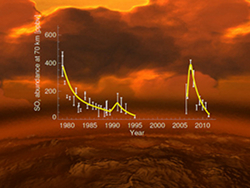Major Discoveries by Venus Express: 2006-2014
2. Recent volcanism?
Radar and gravity mapping of Venus by NASA's Magellan orbiter revealed many thousands of volcanoes and widespread volcanic plains which suggest a planet-wide resurfacing during the last 500 million years. This would seem to imply that the planet possesses active volcanoes at the present time, but direct evidence of this has been difficult to find. Venus Express has contributed to the debate in several ways.
Although the thick cloud blanket, dense atmosphere and high surface temperature mean that small-scale temperature variations on the planet’s surface are extremely difficult to measure, the Visible and Infrared Thermal Imaging Spectrometer (VIRTIS) instrument and the Venus Monitoring Camera (VMC) have both contributed to the study of volcanism on Venus. These instruments can observe thermal emission from the surface at a wavelength of around 1 micron, where it is weakly absorbed by the planet’s atmosphere.
VIRTIS has measured the spectral emissivity of the surface in order to detect variations in chemical composition and they can be used to study the properties of likely Venusian hot spots. In particular, around volcanoes in three of the hot spots (Imdr, Themis and Dione Regiones), VIRTIS data show anomalously high emissivity values. These are interpreted to indicate that the lava flows observed in these regions are relatively unweathered and therefore recent – perhaps a few thousands to a few tens of thousands of years in age.
The VMC has also detected some bright, transient features, including an apparent hot spot in the Ganiki Chasma region. The localised region of higher-than-expected temperature may have been a volcanic eruption or fresh lava flow, although this interpretation of the images is by no means certain.
 |
| Rise and fall of sulphur dioxide. (Further details and credits here.) |
Indirect evidence of a major volcanic eruption has come from large changes in the sulphur dioxide content of the planet's atmosphere. Immediately after arriving at Venus in 2006, the spacecraft recorded a significant increase in the average density of sulphur dioxide in the upper atmosphere, followed by a sharp decrease. One possibility is that the dramatic swing in atmospheric composition was caused by buoyant plumes of volcanic gases released by a large eruption and floating upward.
This is one of the major discoveries made by Venus Express during the last eight years. Read more on the following pages:
| Major discoveries by Venus Express: 2006-2014 |
|
#5. Snow on Venus? |
|
#6. Ozone layer |
|
#7. Water loss |





